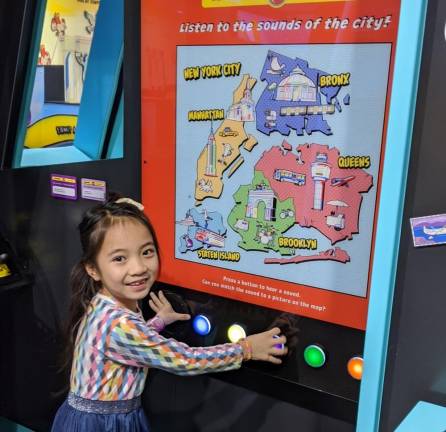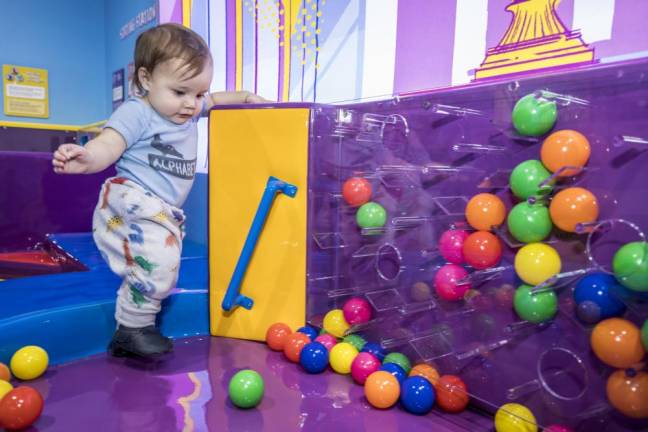Thought Takes Flight at CMOM
In its new Superpowered Metropolis exhibit, the Children’s Museum of Manhattan uses play to help youngsters access higher-level thinking



It’s a bird! It’s a plane! It’s three superhero pigeons on a mission to help children aged 0 to 6 tap into the amazing powers of their rapidly developing brains!
The Children’s Museum of Manhattan created the high-flying narrators — named Zip, Zap, and Zoom — to guide youngsters and their accompanying adults through its newest interactive exhibit, The Superpowered Metropolis: Early Learning City. Through New York City-themed games framed as comic book superhero missions, the exhibit encourages its little visitors to engage with their minds’ executive functions, those advanced thinking skills that, in most people, develop exponentially in their first five years.
At first the idea of tackling something as abstract as brain development in a space for children seemed questionable, until it clicked.
“We spoke with a lot of the different researchers and actually found that the joy of this highfalutin executive function is giving the children control over themselves. It's the executive control over oneself,” recalls Lizzy Martin, CMOM’s director of exhibitions and curator of the Superpowered Metropolis. “The fact that these develop so readily between 0 to 5 was kind of this moment of: Wow! These are superpowers! They're learning superpowers.”
Each of the exhibit’s pigeon mascots represents its own executive function superpower: Zip is the “self-control champion” who encourages young heroes to think before they act and practice pro-social behaviors like taking turns. Zap is the “working memory master,” helping CMOM visitors remember instructions and perform organizing and sorting tasks, while Zoom, the “mental flexibility guru,” shows youngsters how to see situations from multiple perspectives.
In a nod to Superman, kids can start their adventure in the Superpowered Phone Booth, where Zip, Zap, or Zoom will issue them a mission—should they choose to accept it—to engage their growing brains.
Musical Subway Car
On a recent Wednesday morning, little ones exploring the exhibit fed different colored scarves into towering suction tubes at the Whimsical Wind Blowing Fountain. A few seconds later, the scarves came flying out of the top of the “fountain” and drifted gently down to the children eagerly waiting to catch their color and repeat the process.
Further along in the exhibit, two little girls took turns banging out tunes inside the Musical Subway Car, using their working memories to mimic each other’s creations.
Nearby, traffic seemed to be flowing more smoothly on the Supercharged NYC Train Table than on some MTA lines, as miniature engineers navigated multiple routes to reach New York City landmarks.
Features also encourage visitors to develop healthy brain habits. The Superpowered Metropolis’ purple, two-story Treehouse Headquarters (complete with binoculars and a slide) also holds a nap nook underneath so superheroes can rest and recharge between missions.
The Metropolis only features one screen, a tablet located outside the main activity area. On it, kids can play any of three “brain building games” developed by NYU’s CREATE Lab. The games are also available on a smartphone app, so early learners can keep honing their cognitive skills at home.
While the kids clearly appreciate the sounds, colors and challenges, their grown-ups are invited take in some of the research. A plaque near the entrance details findings from the Harvard Center on the Developing Child about the significance of the prefrontal cortex, which grows rapidly in early childhood to enable the first glimmers of the self-control, working memory, and flexible thinking that become so important as we mature.
Leslie Bushara, CMOM deputy director for education and exhibitions, credits Martin for summing up the exhibit’s impact in a headline at the Superpowered Metropolis’ entrance: “Brain skills are at the heart of our actions, ideas, and relationships.”
“I think that that's sort of at the heart of helping parents see that these are foundational skills that set kids up, not just for school success, but for life success,” says Bushara.
"We spoke with a lot of the different researchers and actually found that the joy of this highfalutin executive function is giving the children control over themselves.” Lizzie Martin, CMOM’s director of exhibitions